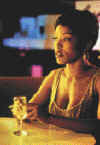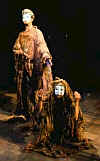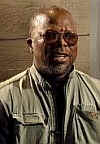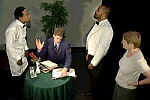|
home
plays
biography
best scene
shop
forum
hot news
photos
much more
- films
- in-depth
- books
-
articles
- glossary
- links
- more links
- search
- site map
- contact
- cold news
all the sites |
Scroll down and click on images for links on the plays.
For links to interviews,
related links, South African history etc click here. |
|
| |
The Last Bus a workshop
piece.
|
 |
Boesman and
Lena (link has gone) Fugard was
inspired to write Boesman and Lena one day when
he saw two figures at a street corner. The man
was carrying a bag of "empties," (empty
bottles which could have brought them a small
amount of money, essential for their meagre
livelihood). The woman followed him carrying on
her head what are probably all their possessions.
She had a little dog on a leash. Fugard said that
in writing the play he wanted to give words to
people who are silenced.
|
 |
Boesman and
Lena (link has gone) Boesman
and Lena, written at a time of mass forced
removals throughout South Africa, is the tale of
a coloured couple who are evicted from their
shack and end up trying to make sense of their
plight around a campfire.
The
original stage version featured white actors in
black roles. The first film version was shot in
1973 and starred Yvonne Bryceland and Fugard.
|
 |
Boesman and
Lena (link has gone) They
contribute to the mood of the film and to our
sense of the characters as living, breathing
human beings, with a past (and a future)
extending beyond the boundaries of the film. More
than the on-location shooting, these moments,
which are always silent (or at least wordless),
free the film from the stage and from the
theatre's basis in language, and create an
interesting tension with the theatricality of the
rest of the movie.
|
 |
Boesman and
Lena ...about an
impoverished black South African couple who fall
into a Beckett-like argument when they're chased
from their shantytown by ruthless white
developers.
...Bassett, in
particular, stinks up the joint by playing
virtually every emotion to the kids in the cheap
seats.
|
 |
Boesman and
Lena We almost
expect them to devour each other, so relentless
is their verbal sparring.
|
 |
Boesman and
Lena Craig W. McLuckie
Twentieth Century Literature, Winter 1993
Fugard,
like Beckett and Camus, seeks an answer to Camus'
question of why these people do not commit
suicide when faced with the absurdity and squalor
imposed on their lives. In Boesman and Lena the
answer to the question is forestalled by the lack
of a complete and truthful consciousness of the
self. Lena is preoccupied with uncovering her
identity, which she believes is held in her past
and in an other's recognition of her. Boesman,
contrarily, fears an encounter with his self
because his false sense of identity might be
brought into question.
|
 |
Boesman and
Lena Jack Barbera
Twentieth Century Literature, Winter 1993
What
particular advice can you remember Mr. Fugard
giving about your characters and how to act them?
MOKONE: For me the advice was
"Write your own journey." The script
from time to time says my character, the old man,
murmurs something in Xhosa, but doesn't say what.
Actors before me who had played the role, like
Bloke Modisane, had written their own journey, so
I followed their example and wrote my own story.
|
| |
Friday's
Bread on Monday
|
| |
Orestes
|
 |
Statements
after an Arrest under the Immorality Act
Andre Brink
Twentieth Century Literature, Winter 1993
The
most obvious device, already broached in the
discussion of role-playing, involves the peopling
of the theatrical space of the play with a wide
variety of representatives from the society which
surrounds the action and the actors. In
Statements . . . the policeman represents not
only the System, the forces of law and order,
but- notably through the statement of Mrs. Buys-
the outside world which invades the lovers'
haven. In both the other plays the two central
actors themselves represent the absent multitude-
all the more persuasive because in their
invisibility they come to inhabit, to possess,
the actors... In Statements, of course, the woman
is physically present as "the other person
on the floor". Yet from the beginning, even
before the intervention of the Immorality Act,
the relationship between the play's protagonists
is in the process of breaking down ("Is
there nothing any more we can do except hurt each
other?"). If she represents an attempt
toward human wholeness ("And he . . . And I
. . . And we . . ."), it is the failure of
this wholeness, through a progressive exclusion
and denial of the woman by the man toward the
end, that results in the irremediable bleakness
of the outcome, a near-total darkness quite
uncharacteristic of Fugard.
|
 |
Statements
after an Arrest under the Immorality Act
Eric Grode
Broadway.com
The racial and power
dynamics between the two, largely submerged at
first, shift to the forefront once the two are
arrested (the Immorality Act forbade interracial
sex). What started as a fairly linear play
splinters into a series of poetic monologues that
vary in quality.
|
 |
Sizwe
Bansi is Dead Developed by
Fugard in collaboration with the two actors, John
Kani and Winston Ntshona.
|
 |
Sizwe
Bansi is Dead Andre Brink
Twentieth Century Literature, Winter 1993
This
reading of Fugard's dramaturgy in Sizwe Band
returns us to what he himself, at a time when he
was a particularly enthusiastic exponent of Jerzy
Grotowski's Poor Theatre, regarded as basic to
the theatrical experience: an "immediate and
direct relationship with our audience". It
means that for a more comprehensive evaluation of
the interaction between aesthetics and politics
we should look at the text as performance, i.e.,
as part of an experience that has no
"outside" to it. In such a reading the
audience assumes a vital importance. The
narrative in the play may indeed present images
of closed circles in which Buntu's words
reverberate ad infinitum: "There's no way
out, Sizwe." But the act of confronting an
audience with such images cannot but stimulate a
response, and this in itself is already a
breaking of the circle. In the narrowest sense of
the word, the play can be read as the response by
a group of artists to the challenge of a
sociopolitical situation. In performance it is
the play that acts as challenge to elicit a
response from the audience. "Freedom is the
freedom to say that two plus two make four. If
that is granted, all else follows," said
Orwell (81).
|
 |
The Island
(link has gone) costume
designs
|
 |
The Island Fugard, who
had to hoodwink the apartheid authorities by
saying Kani was his driver and Ntshona his
gardener - when he had neither a car nor a garden.
|
 |
The Island performance
photos
UAF Lab Theatre 1996 |
 |
The Island John Kani on
Island
Attempts by the SA government to ban it proved
fruitless. Because Kani, Ntshona and Fugard had
committed it to memory, there was no existing
script that censors could ban....
It
has also been translated into more than 30
languages. Kani says he is sometimes surprised by
royalty cheques made out in roubles.
|
 |
The Island The play
follows two political prisoners at the notorious
Robben Island jail as they rehearse their two-man
version of Sophocles' Antigone for the
prison's annual concert. It's based on the true
story of Norman Ntshinga, a black actor cast as
Haemon in a version of Antigone that
Fugard directed in the '60s. During a police
raid, the actor was arrested under suspicion of
being a member of the then-banned African
National Congress and sentenced to 10 years at
Robben Island.
"He was
an enormously talented and very passionate
actor," Fugard recalls. "He was almost
as devastated not to have the chance to play the
role as he was to go to prison. I later received
a letter from him that someone smuggled out. He
told me he had performed a 10-minute, two-man
version of Antigone at a prison concert
that he adapted from memory. It was just an
extraordinary story. I recognized right away that
it would make a great play."
|
 |
The Island (link has gone) I suppose
Kani and Ntshona are now too well-padded to be
playing hungry, ill-treated prisoners, but there
is no mistaking the poignancy, the authority or
the depth of their remarkable performances. This
is a play, and a production, of genuine nobility,
and it left this viewer feeling both moved and
humbled.
|
 |
The Island (link has gone) Peter
Brook on Island
Peter Brook's influence on modern theatre is so
pervasive that when he says a production
influenced him, you can't help but take notice.
The renowned director...was affected by the 1973
production of The Island.
|
 |
The Island (link has gone) Mandela,
Robben Island and Island
One year in the late 1960s, the play chosen for
performance at Christmas by inmates of South
Africa's notorious Robben Island prison was
Antigone. In Athol Fugard's memorable version of
the event in The Island, Sophocles was given a
new lease of life, with particular and poignant
relevance to the struggle for liberation from
apartheid in South Africa. In the Robben Island
production, the man who volunteered to play Creon
had very little stage experience, his only prior
role of some note having been, significantly,
that of John Wilkes Booth, president Abraham
Lincoln's assassin, in a college show. That man
was Nelson Rolihlahla Mandela. Although, like his
fellow actors, he primarily identified with
Antigone, he brought to the interpretation of
Creon what must have been, in retrospect, a peculiar insight.
|
 |
The Island John Kani,
Crossings
With The Island
there was an interesting situation. Everybody
knew there was a Robben Island, Mandela was on
Robben Island; everybody knew there were people
in detention, people underground; everybody knew
people in exile. But people were afraid to touch
this subject. We had to find a way of talking
about these things, of telling the story.
What we discovered after creating
Sizwe Bansi was that we couldn’t have the
text written down. This was because it would have
been a document; it would have meant that the
police would have evidence that could be
presented to a District Attorney who might lay
charges against us. So we kept continuing to
improvise according to the interactions and
response with the audience. That way we used our
life experience, structured it around a story, to
take the audience on a journey through to the end
of the evening.
|
 |
The Island (link has gone) Chris Jones, Chicago
Metromix
As they enact the Greek
tragedy, they discover that the civil
disobedience of the mythical heroine must be
translated to their own situation. This is a play
about the arts as a tool of empowerment and the
simplicity of its narrative merely adds to its
weight.
|
 |
Dimetos Gerald Weales
Twentieth Century Literature, Winter 1993
His
method in Dimetos was even less characteristic.
There he tried to embody the idea in a man, but
one who lived in no recognizable place, no
identifiable time. Still working with the play
after its first production at Edinburgh, he
indicated that he was thinking of the time of the
play "without letting any specifics creep
onto the page" but that he had "two
specific settings in my imagination"
(Notebooks 219). Working tools, presumably, for
they never moved from his imagination to the
stage. Certainly the New Bethesda that became the
"remote province" of Act One of Dimetos
has none of the substantiality of the New
Bethesda outside Miss Helen's door in The Road to
Mecca.
|
 |
The Guest (link has gone) BFI
Athol
Fugard plays the Afrikaner intellectual,
naturalist, poet, author and rebel Eugene Marais,
who publicly attacked Kruger's repressive
Transvaal government and raised hackles by
lecturing on 'The Joys of Opium'. Focused on when
he was trying to overcome morphine addiction on a
remote farm, Devenish's film is a dark, poetic
examination of a life which, in Marais' words,
was 'founded on pain and sorrow'.
|
 |
A Lesson from
Aloes Gerald Weales
Twentieth Century Literature, Winter 1993
The
three characters in Aloes--distantly based on
people mentioned in Notebooks as early as
1961--are veterans of the struggles in a cause
that--for two of them at least--has come to seem
false, a kind of ideological self-delusion that
made their idealism and their sense of community
appear to be politically important.
|
 |
A Lesson from
Aloes Two analogies
come to mind. First, I think of the elaborate
nine-tiered racial classification upon which the
apartheid system was based. Every person in South
Africa was classified soon after birth, based on
a complex set of decision rules that included, if
necessary, determining the color of the skin
beneath the fingernails. No one could exist
between or outside the system. To be was to be
classified. From this perspective a
"new" type of aloe plant would be
impossible.
A second analogy resides in the aloe's endurance.
They make their home and thrive in seemingly
hostile territory. What they are they are. To
transplant an aloe plant to England, or to some
other lush environment, won't be successful,
because it would have to compete with other
plants that are already adapted to the cool,
rainy environment. It makes no sense to ask an
aloe why it prefers to remain in the drier
climate.
|
 |
The Drummer Gerald Weales
Twentieth Century Literature, Winter 1993
The
Drummer, the five-minute mime piece he wrote for
the Actors Theatre of Louisville in 1980, grew
out of an image he found in New York- a derelict
playing with drumsticks.
|
 |
´Master
Harold`...and the boys This play
has been accused in some quarters of
personalizing racism and avoiding confrontation
of its systemic, societal qualities. What do you
think of this argument? What do you think is the
significance of the play's title?
|
| Master Harold |
´Master
Harold`...and the boys (link has gone) These
differing influences caused Fugard to use the
discussions between Sam and Hally to demonstrate
the religious, racial, and political tensions of
his lifetime in South Africa.
|
 |
´Master
Harold`...and the boys The play
begins and ends with Sam and Willie alone on
stage, their relationship framing the interaction
with Hally. Does this technique serve to
highlight the centrality of Hally's presence, or
marginalize him, in your opinion?
|
 |
´Master
Harold`...and the boys

"It was
difficult to realize that I'd have to spit in my
friend's face during every performance. During
the show, which runs without intermission, I have
to stay in the moment and stay in character in
order to deal with this awkward situation. This
is a very actor-driven show, and I feel a lot of
responsibility playing the title role."
|
 |
´Master
Harold`...and the boys John O. Jordan
Twentieth Century Literature, Winter 1993
Structurally,
the play has three main sections: a prelude when
Sam and Willie are alone on stage; a long middle
section when Hally is on stage, storming around
and "bumping" into people and things;
and a brief postlude when Sam and Willie are
again alone together.
|

|
The Road to
Mecca A 20 page
resource pack about The Road to Mecca.
The
topics covered include a synopsis, a biography of
Fugard, directing the play, lighting, background
on South Africa, classroom ideas.
"I love words and ´the space
between words´ which is a phrase of Fugard´s´.
There is a lot of dialogue in the play and each
character has an individual style.... the almost
aggressively active Elsa provokes a seemingly
passive Helen to explain why she feels as she
does..." .
This is highly recommended.
|
 |
The Road to
Mecca The
"Mecca" metaphor speaks to the
relationship between imagination and freedom.
Likewise, Miss Helen's candles illuminate the
deep connection between creativity and light.
Miss Helen's Afrikaner community expected her to
shrivel up and die after her husband's death; for
them, the "right" thing to do was for
her to close the drapes to keep out the light.
|
 |
The Road to
Mecca (link has gone) David
Edwards, The Blurb, 2002
The play, originally
written in1984, is a remarkably complex piece of
work. There are only three characters, and the
entire production takes place in one room. But in
that space, Fugard creates a remarkable parable.
The piece works on several levels; as a character
study of the three participants, an allegory
about the problems (past and present) of South
Africa, and as an examination of human frailty
and strength.
At
the time it was first produced, The Road to Mecca
must have been dynamite in South Africa. Despite
no black character ever appearing on stage, the
work challenges and confronts both the immediate
issue of apartheid, and the deeper question of
racism in all its forms.
|
 |
The Road to
Mecca Mecca is
about the freedom of the human spirit. Two
characters, Elsa and Marius fight for the soul of
Miss Helen. Finally, it is Miss Helen alone who
decides what Miss Helen will do.
|
 |
The Road to
Mecca Janet Ruth
Twentieth Century Literature, Winter 1993
it
is unusual to find a man exploring the
complexities of women's relationships, which is
precisely what Athol Fugard does in The Road to
Mecca (first performed in 1984 at the Yale
Repertory Theater). He uses the dose friendship
between Helen and Elsa to explore many issues,
especially the isolation of the artist and other
rebels and the ability of an artist to nurture
younger friends. These universal themes enable
the play to transcend mere character studies and
to articulate the deepest needs of both men and
women.
|